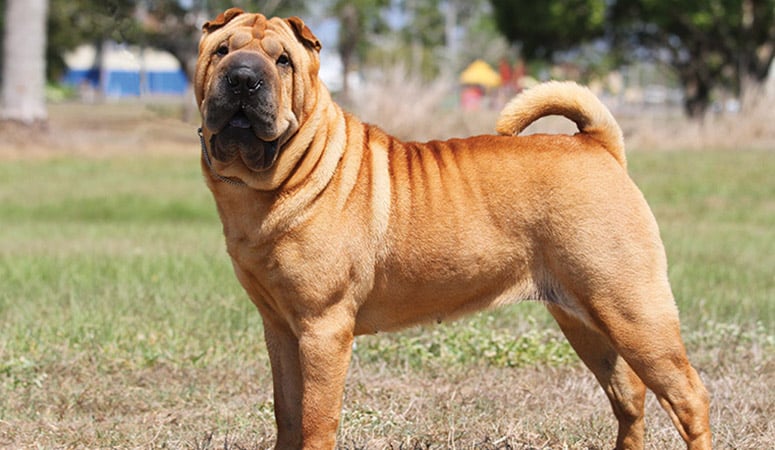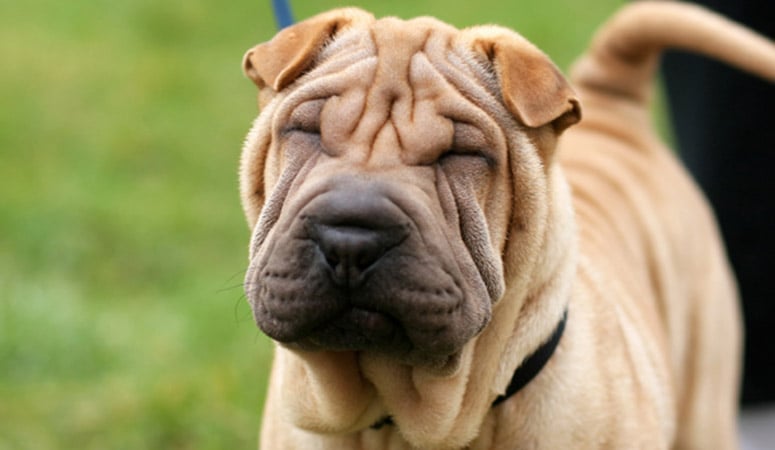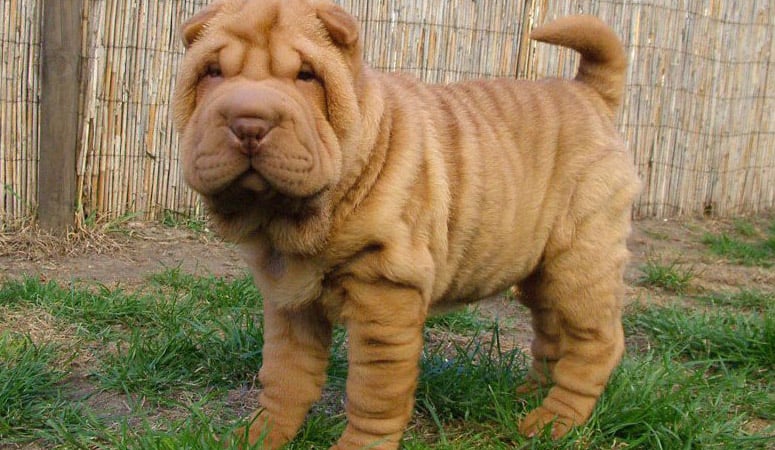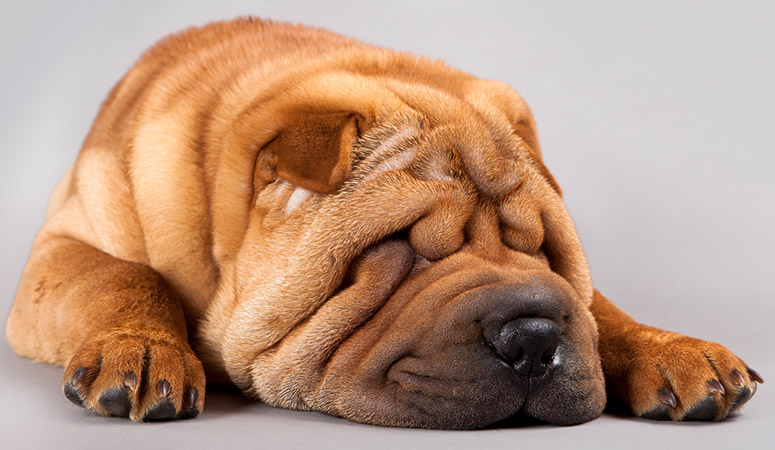Chinese Shar-Pei

With medium size and odd physical traits—a blue-black tongue, small, sunken eyes, a broad “hippopotamus” muzzle and a scowling expression, the Chinese Shar-Pei was fascinating and intelligent, which makes him a good guardian dog and great companion of people. Fascinating but challenging, the breed is loyal to the family but unfriendly to the strangers.
| Other Names | Chinese Fighting Dog, Shar-Pei |
| Color | Apricot Dilute, Black, Black Sable, Blue, Fawn, Red, Blue Dilute, Chocolate Dilute, Cream Dilute, |
| Height | Males: 17-20 inches. Females: 17-20 inches. |
| Weight | Males: 40-60 pounds. Females: 40-60 pounds. |
| Life Span | 8-12 years |
| Personality | Loyal, Independent, Calm |
| Exercise | Regular Exercise |
| Origin |
| Popularity | #65 |
| Groom Needs | Occasional Bath/Brush |
| Kids Friendly | No |
| Dog Friendly | No |
| Watch Dog | |
| Family Dog | Yes |
| Litter Size | 4-6 puppies |
Chinese Shar-Pei Pictures
Chinese Shar-Pei Video
Introduction
Known for their intelligence, doggedness, vigor, devotion, and trainability, Shar Pei gives you more than you require in a non-sporting dog. Their short, hard, and bristle coat come in all solid color varieties except white. The modern Shar-Pei are unlike their progenitors in having a well-wrinkled skin. Their sturdy build is an adaptation for their versatility as old peasant dogs.
Shar-Pei are rather medium-sized dogs of great strength. An average Shar-Pei stands 18-21 inches at the shoulder and weighs around 45-60 pounds, regardless of the gender. They are good companions of the family and yet they keep aloof from strangers. These dogs of ancient ancestry still possess the keen sight and elegance of a good watchdog. Shar-Pei has an average lifespan of 9-12 years. They are ranked 64th most popular dog breed by the American Kennel Club.
Living with Chinese Shar-Pei
Clean dog with very little odor, the Chinese Shar-Pei has minimal grooming requirements to keep him looking his best. As easy parts of grooming for the Shar-Pei, brushing and bathing are necessary to remove dead hair and dirt.
Brushing with a grooming mitt or rubber curry once a week and bathing once every 12 weeks are sufficient, but he doesn’t need bathing a lot, unless he has been rolling in the mud, because frequent baths may hurt his skin.
It’s difficult but essential to get him dry after a bath, especially the folds and wrinkles, and if not, he may suffer from a yeast or fungal infection.
Trimming nails once or twice a month can help prevent painful tears and other problems. With blood vessels in his toenails, if you cut too far you may lead to bleeding, your dog may not cooperate the next time he sees the nail clippers. So you should ask a vet or groomer for pointers if you’re not experienced trimming dog nails.
Brushing your Shar-Pei’s teeth at least two or three times a week can remove tartar buildup and the bacteria that lurk inside it and daily brushing will be better for preventing gum disease and bad breath.
Special care should be taken with the Shar-Pei’s ears for they are easy to get ear infections and water in the ears will worsen the problem.
Being moderately energetic and with medium size, the Shar-Pei does not need a lot of exercises. Too much exercise will increase the pressure on their joints and bones, which could result in causing a dog a few problems later on in their lives. They should not be allowed to run up and down the stairs or jump up or off furniture.
A quick walk of 30 minutes every day or lively games, such as Fetch, 2 or 3 times during the day is necessary to burn off energy, especially when the weather is warm. But the game should be short and energetic.
The breed should exercise both mind and body by taking part in tracking, obedience, rally, agility and other activities, and the dog and owner will enjoy.
A Chinese Shar-Pei should have a healthy and balanced diet, and Good meats and poultry are good choice for this breed. Incorporating other whole ingredients into a dog’s diet is very important for the dog to keep a healthy coat and body. The amount of the food depends on the dog’s size, age, build, metabolism, and activity level.
Follow the feeding schedule and stick to the same routine, which can help avoid any tummy upsets if you get a Samoyed puppy. You can change a puppy’s diet, but you should put them back on their original diet and check with the vet if they have any digestive upsets.
A mature dog should be fed with food of good quality twice a day to meets their nutritional requirements. But you should be care about its calories consumption and weight to keep it from obesity, which will shorten a dog’s life.
Clean, fresh water should be available at all times.
The breeder should learn about which human foods are safe for dogs, and which are not. If there are any concerns about your dog’s weight or diet Check with your vet.
Just like people, all dog breeds have the potential to develop genetic health problems. Some unusual and specific health concerns in the Chinese Shar-Pei breed include Skin allergies and infections, Hip dysplasia, Knee and joint concerns, Hypothyroidism, Eye conditions, Shar-Pei fever, Cancer, Gastric torsion (bloat), etc.
The breeders who don’t offer a health guarantee on puppies or tell you that breed is totally healthy without any problems are not responsible. A good breeder should be honest and care about their dogs and tell the exact symptoms of the dog and the incidence with which they occur in her lines to prevent some serious diseases.
The Chinese Shar-Pei Club of America, website of the breed’s national parent club, provides detailed breed-health information for owners. Some health test should be done regularly, including thyroid, ophthalmologist, hip, elbow and patella evaluation.
Total Annual Cost: $3177.9
Cost is estimated for the first year and may vary depending on many factors, such as dog food, health care, leash, collar, licensing, possible fencing, crates, training and obedience classes, dog-walking, grooming, treats, toys, flea, tick, and heart-worm meds, microchips, etc.
With nature of stubbornness, Shar-Pei is quick to learn something by proper motivation, such as food. Early socialization and puppy training classes are helpful to ensure that the Shar-Pei develop as a well-adjusted, well-mannered companion.
Establish your place as pack leader and do not give the Shar-Pei an inch will help develop a well-behaved adult dog.
Guarding behaviors and discouraging nipping from his young age can prevent dangerous situations in the future. When your puppy nips, you get up and walk away. And you should always discourage play biting, but do not interact with him, instead, ignore the rough, rude behavior and offer lots of praise for gentle play.
Shar-Pei will benefit from continued training and learn some entertaining tricks, although he is not a top candidate for agility or advanced obedience training.
They are not well-suited to strenuous activity or extreme temperatures. If you teach them with love and consistency, however, they are a joy.
History
The Chinese Shar-Pei dog breed has a vague and largely undocumented history, like many Chinese dog breeds. It is believed, however, to have originated from ancient dogs of the Southern province of China as far back as the Han Dynasty, some 2,000 years ago. The Shar-Pei dogs were peasant dogs and, as such, were utilitarian in that they were gun dogs, herd dogs, guard dogs, as well as sporting dogs (for they were bred to participate in dogfights too). It wasn’t until the 19th century that the Shar-Pei dogs caught the attention of Western travelers, who identified them as the Chinese fighting dogs.
Towards the middle of the 20th century, due to the political hysteria in China, with the Communist party shunning all dog activities in the People’s Republic of China around the 1940s, organized killings of several dogs of Chinese origin took place at the time. Although a few Shar-Pei dogs lived through the time to form a modern generation of the breed, the blow from this turmoil to their population almost drove the Shar-Pei breed to extinction. The survivors were later congregated in parts of Taiwan and Hong Kong.
A wealthy Hong Kong breeder, Matgo Law, drew the attention of the international communities (especially the United States) to rescue the Shar-Pei breed which was on the brink of fading out around the 1970s, with only a few hundreds of its members left. Dog fanciers pooled resources together and soon the breed was salvaged from the claws of extinction. The Shar-Pei breed was later recognized by the American Kennel Club in 1992.
Helpful Information
Breed Club: CHINESE SHAR-PEI CLUB OF AMERICA, INC.
Breed Club Link: http://www.cspca.com/
Breed Club Rescue: CSPCA RESCUE GROUPS
Breed Club Rescue Link: http://www.cspca.com/pdfs/rescuegroups.pdf




